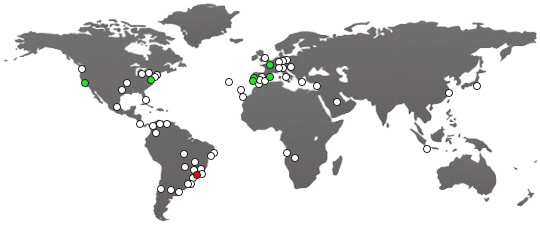The medical plant Aloe Arborescens treats the disease Bruises more efficiently than Aloe Barbadensis (Aloe Vera)
Research from the Palatini Institute in Salzano, Venice, Italy, rvealed that Aloe Arborescens is 200% richer in medicinal properties than Aloe Barbadensis (Aloe Vera).
Aloe Arborescens is of all known plants the plant with the highest number of identical enzymes in our body: it fills 73 of the main 95 enzymes of the human body.
According to multiple scientific reports, Aloe Arborescens is extremely effective in the following areas: it detoxifies and cleanses blood vessels; Is effective in intestinal health, heartburn, reflux, gastritis and other diseases resulting from the malformation of the Immune System.
A contusion, commonly known as a bruise, is a type of hematoma of tissue in which capillaries and sometimes venules are damaged by trauma, allowing blood to seep, hemorrhage, or extravasate into the surrounding interstitial tissues. Bruises, which do not blanch under pressure, can involve capillaries at the level of skin, subcutaneous tissue, muscle, or bone. Bruises are not to be confused with other similar-looking lesions primarily distinguished by their diameter or causation. These lesions include petechia (< 3 mm result from numerous and diverse etiologies such as adverse reactions from medications such as warfarin, straining, asphyxiation, platelet disorders and diseases such as cytomegalovirus), purpura (3 mm to 1 cm, classified as palpable purpura or non-palpable purpura and indicates various pathologic conditions such as thrombocytopenia), and ecchymosis (>1 cm caused blood dissecting through tissue planes and settled in an area remote from the site of trauma or pathology such as periorbital ecchymosis, i.e.,"raccoon eyes" , arising from a basilar skull fracture or from a neuroblastoma). As a type of hematoma, a bruise is always caused by internal bleeding into the interstitial tissues which does not break through the skin, usually initiated by blunt trauma, which causes damage through physical compression and deceleration forces. Trauma sufficient to cause bruising can occur from a wide variety of situations including accidents, falls, and surgeries. Disease states such as insufficient or malfunctioning platelets, other coagulation deficiencies, or vascular disorders, such as venous blockage associated with severe allergies can lead to the formation of purpura which is not to be confused with trauma-related bruising/contusion. If the trauma is sufficient to break the skin and allow blood to escape the interstitial tissues, the injury is not a bruise but instead a different variety of hemorrhage called bleeding. However, such injuries may be accompanied by bruising elsewhere. Bruises often induce pain, but small bruises are not normally dangerous alone. Sometimes bruises can be serious, leading to other more life-threatening forms of hematoma, such as when associated with serious injuries, including fractures and more severe internal bleeding. The likelihood and severity of bruising depends on many factors, including type and healthiness of affected tissues. Minor bruises may be easily recognized in people with light skin color by characteristic blue or purple appearance (idiomatically described as "black and blue") in the days following the injury.
Text origem Wikipedia. More information at
https://en.wikipedia.org/wiki/Bruise








